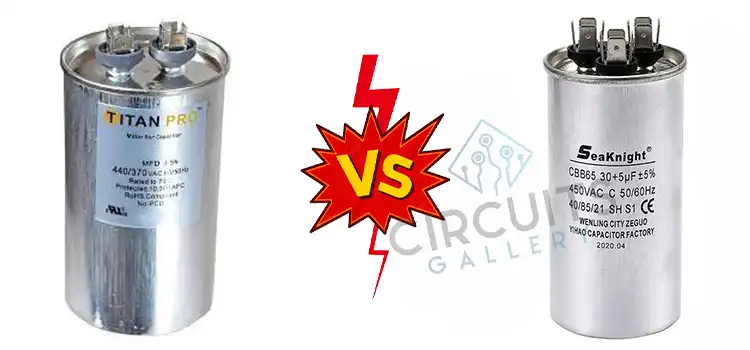370 vs 440 Capacitor | Which One is Right for Your Induction Motor
370 and 440 capacitors simply mean 370 VAC and 440 VAC capacitors. These two capacitors are most commonly used as run capacitors of an AC induction motor. Between 370 VAC and 440 VAC capacitors, it is always preferable to use the 440 VAC capacitor.
440 VAC capacitors can handle 70 Volts more than the 370 VAC one, the 440 Volt one can also handle higher back EMF created by the motor. So, it is always preferable to use the 440 VAC capacitor instead of the 370 VAC capacitor to ensure a greater margin of safety.

Between 370 & 440 Which One is Ideal for Your AC Induction Motor?
370 VAC and 440 Vac are the two most commonly used capacitors as the run capacitor of an AC induction motor. These capacitors give the initial boost to the motor to start running and provide continuous power to the motor to ensure that the motor runs smoothly.
The rule for choosing a capacitor for any appliance is, that its voltage rating must be √2 times higher than the maximum possible voltage that the capacitor may face. For example, a 220 V supply’s maximum voltage may be 250 volts. So, the voltage rating of any capacitor used in this system should be √2×250 volts ≈ 354 volts.
Using a 370 VAC capacitor in a 220 V system is perfectly safe, but it is always preferable to have a greater margin of safety for costly appliances. So, it is recommended to use a 440 VAC capacitor in place of a 370 Volt one, although the 370 Volt one is also safe to use.
Can I Use a 370V Capacitor Instead of a 440V?
No, a capacitor with a lower-rated voltage cannot be used to replace a capacitor of a higher voltage rating. So, a 370 V capacitor cannot be used in place of a 440 V capacitor. But, doing the opposite is completely safe and always recommended by professionals for an added safety margin.
What Is the Difference Between 370 Vac and 440 Vac Capacitors?
370 VAC and 440 VAC indicate the maximum alternating current voltage rating of a capacitor. It is the maximum voltage that the capacitor can safely handle. Having a capacitor with a higher voltage rating is always recommended because it provides a higher margin of safety.
Can I Use a Higher-Rated Run Capacitor?
Yes, a higher voltage rated capacitor can be used instead of a lower voltage one as the run capacitor of a motor. But the capacitance of the two capacitors must be identical. It is a good practice to use a higher-rated capacitor if possible. Because it can handle greater supply voltage spikes and back EMF generated by the motor.
What Does the VAC on a Capacitor Mean?
The VAC rating of a capacitor is the maximum alternating current voltage that the capacitor can safely handle. It is the second most important rating of a capacitor, the capacitance rating being the first. It is extremely important to use the proper VAC-rated capacitor, otherwise, accidents may happen.
Frequently Asked Questions
Can a different capacitance capacitor be used?
No, a capacitor with a different capacitance cannot be used instead of the rated capacitance capacitor. It may work to some extent but should be never done in practice. On the other hand, using a capacitor with a greater voltage rating is perfectly safe and widely practiced.
Conclusion
A 440 VAC capacitor can be used in place of a 370 VAC capacitor. But doing the opposite is not possible. When choosing between 370 VAC and 440 VAC capacitors, it is preferable to use the 440 VAC one because it ensures a greater margin of safety.
Subscribe to our newsletter
& plug into
the world of circuits